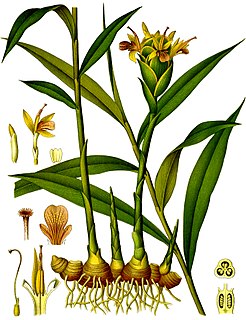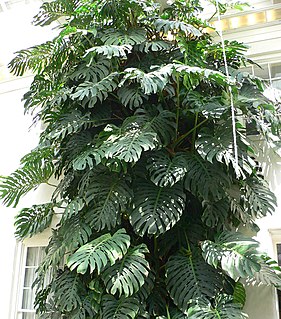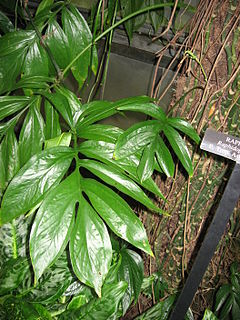
Rosaceae, the rose family, is a medium-sized family of flowering plants that includes 4,828 known species in 91 genera.

The genus Zingiber is native to Southeast Asia especially in Thailand, China, the Indian Subcontinent, and New Guinea. It contains the true gingers, plants grown the world over for their culinary value. The most well known are Z. officinale and Z. mioga, two garden gingers.

Arisaema is a large and diverse genus of the flowering plant family Araceae. The largest concentration of species is in China and Japan, with other species native to other parts of southern Asia as well as eastern and central Africa, Mexico and eastern North America. Asiatic species are often called cobra lilies, while western species are often called jack-in-the-pulpit; both names refer to the distinctive appearance of the flower, which consists of an erect central spadix rising from a spathe.

Podophyllum is a genus of flowering plant in the family Berberidaceae, native from Afghanistan to China, and from southeast Canada to the central and eastern United States. The genus was first described by Carl Linnaeus in 1753.

Polemonium, commonly called Jacob's ladders or Jacob's-ladders, is a genus of between 25 and 40 species of flowering plants in the family Polemoniaceae, native to cool temperate to arctic regions of the Northern Hemisphere. One species also occurs in the southern Andes in South America. Many of the species grow at high altitudes, in mountainous areas. Most of the uncertainty in the number of species relates to those in Eurasia, many of which have been synonymized with Polemonium caeruleum.

Schizostachyum is a tall or shrub-like tropical genus of bamboo. They are natives mostly of tropical Asia and Papuasia, with a few species in Madagascar and on certain islands in the Pacific. A few have become naturalized in other tropical regions.

Microsorum is a genus of ferns in the family Polypodiaceae, subfamily Microsoroideae, according to the Pteridophyte Phylogeny Group classification of 2016 (PPG I). The species are tropical. Like most ferns, they grow from rhizomes, rather than roots. The genus name is often misspelled "Microsorium" or "Microsoreum". It includes some species that are lithophytic rheophytes.

Disporum is a genus of about 20 species of perennial flowering plants, found in Asia from northern India to Japan, south to Indonesia and north into the Russian Far East.
Leptobrachium hainanense, the Hainan pseudomoustache toad, is a species of amphibian in the family Megophryidae. It is endemic to the mountains of central and southwestern Hainan Island, China. Before being recognized as a separate species, it was confused with Leptobrachium hasseltii.

Hopea is a genus of plants in the family Dipterocarpaceae. The genus was named after John Hope, 1725–1786, the first Regius Keeper of the Royal Botanic Garden, Edinburgh. It contains some 113 species, distributed from Sri Lanka and southern India to southern China, and southward throughout Malesia to New Guinea. They are mainly main and subcanopy trees of lowland rainforest, but some species can become also emergent trees, such as Hopea nutans.
Amydrium is a genus of flowering plants in the family Araceae that is native to Southeast Asia, southern China, and New Guinea.

Monsteroideae is a subfamily of flowering plants in the family Araceae.

Isorhapontigenin is a tetrahydroxylated stilbenoid with a methoxy group. It is an isomer of rhapontigenin and an analog of resveratrol. It is found in the Chinese herb Gnetum cleistostachyum, in Gnetum parvifolium and in the seeds of the palm Aiphanes aculeata.
Rhizobium hainanense is a Gram negative root nodule bacteria. Strain CCBAU 57015 (166) is the type strain.
Hypericum ellipticifolium is a flowering plant in the family Hypericaceae. It was formerly included in the genus Lianthus, which was described by Norman Robson in 2001. It is native to southern China.
Teratophyllum is a genus of ferns in the family Dryopteridaceae, subfamily Elaphoglossoideae, in the Pteridophyte Phylogeny Group classification of 2016. The genus is native to Malesia.
Chieniodendron is a genus of plant in the Annonaceae family. It has only one species Chieniodendron hainanense native to mainland China and Hainan. It is threatened by habitat loss.
Amydrium humile is a flowering plant in genus Amydrium of the arum family Araceae.
Amydrium sinense is a flowering plant in genus Amydrium of the arum family Araceae.

Amydrium zippelianum is a flowering plant in genus Amydrium of the arum family, Araceae. Its pattern is very distinctive and is sometimes cultivated as an ornamental plant.











